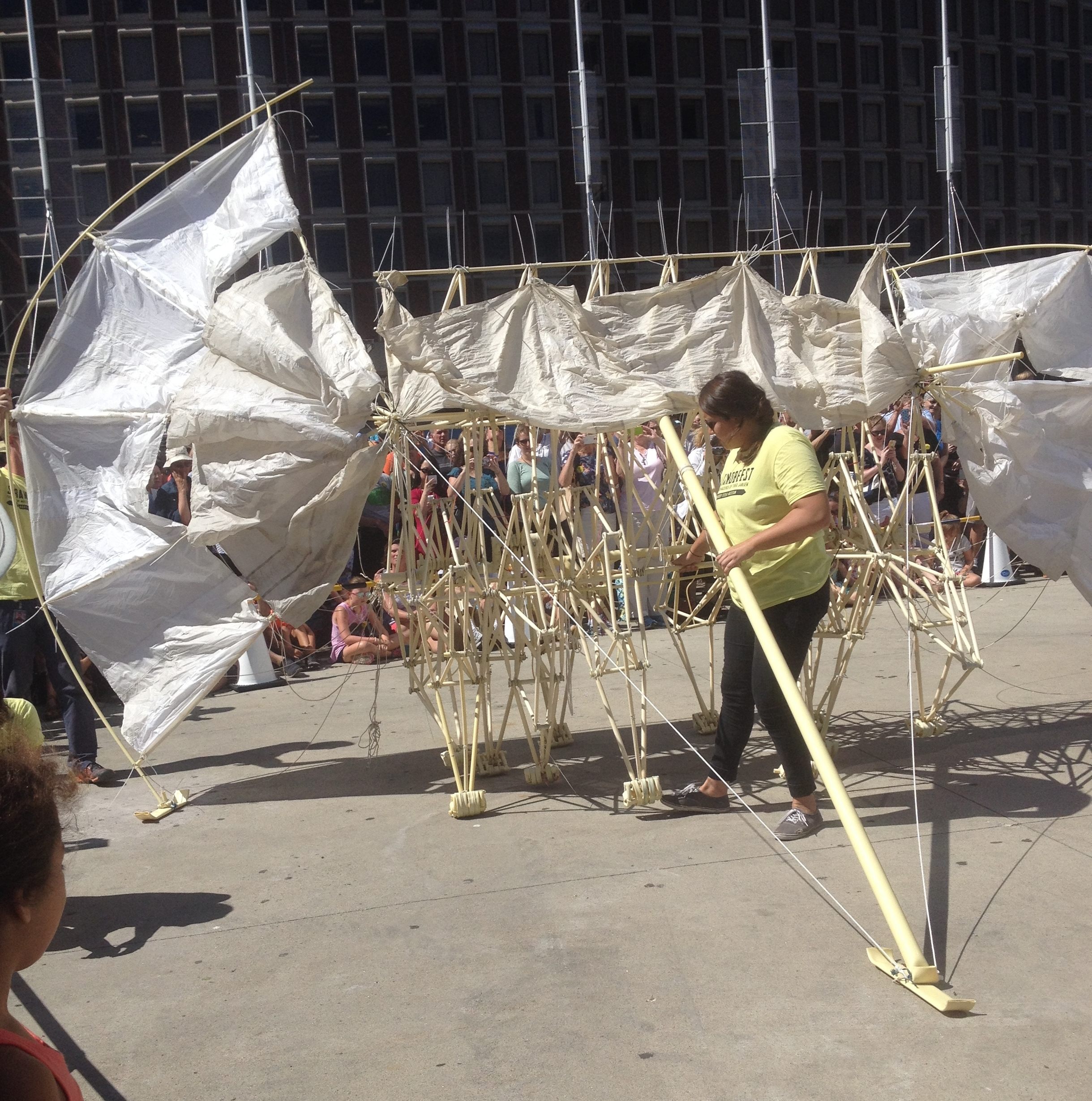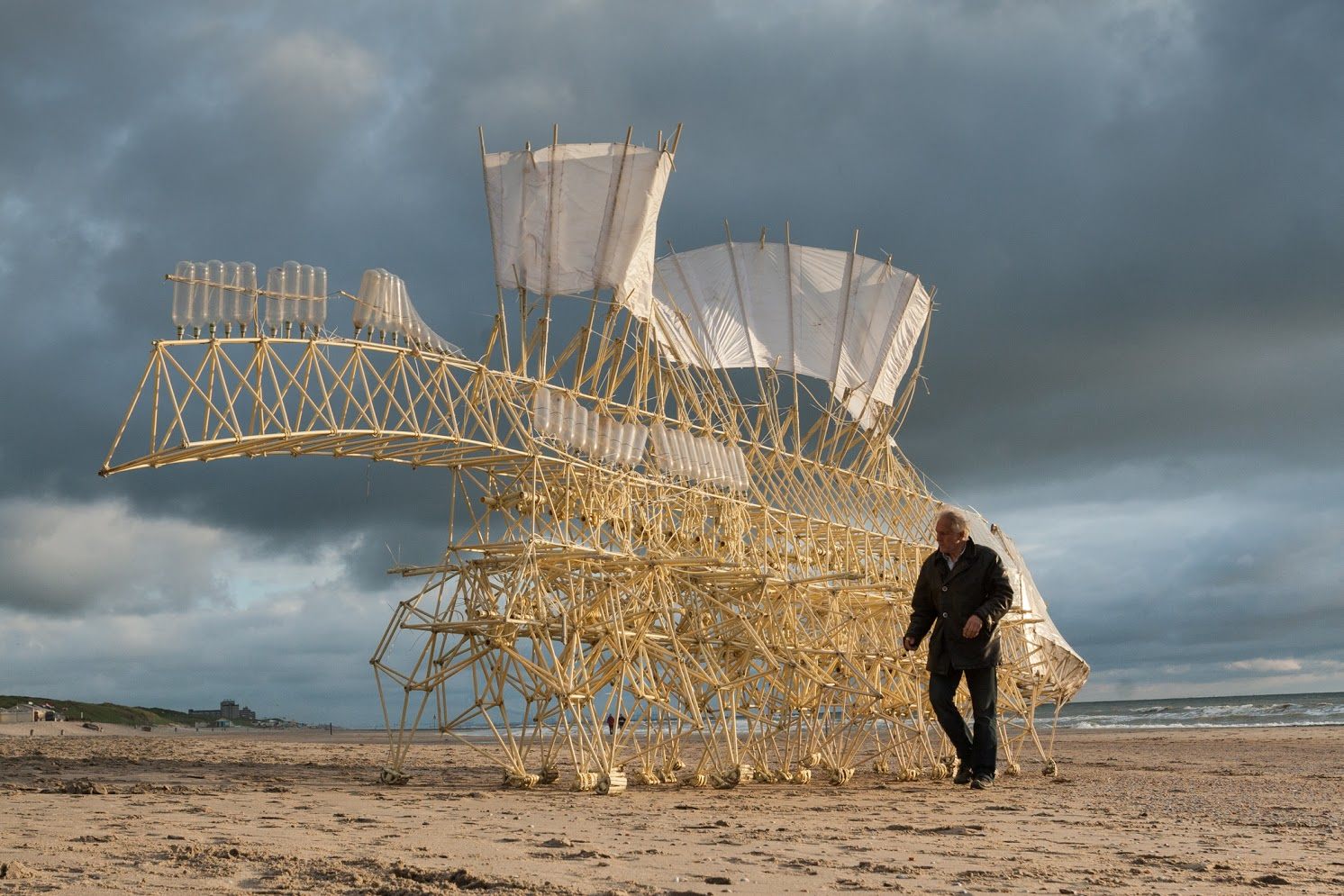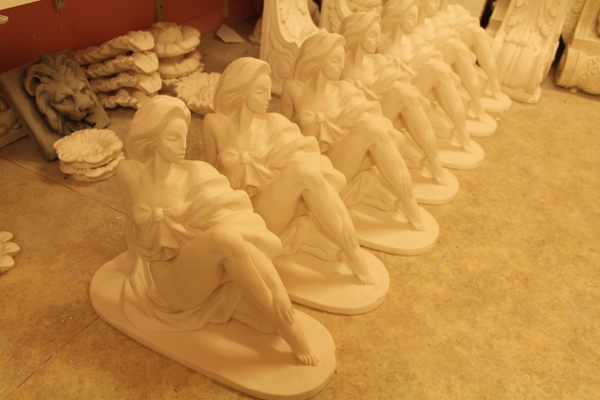Mechanical Beach Monsters No Match for Boston Crowd Control

A Peabody Essex Museum volunteer coaxes a Strandbeest forward. (Photo: Atlas Obscura)
Strandbeest Handler #4 was having some trouble. It was time to promenade, and her charge—a ten-foot-long scaffold of tan PVC pipes, flanked by two outstretched sails—had stage fright. Its 12 legs, normally eager to show off their perfectly calibrated stride, were frozen in place. As she tugged on one of its extremities, the scratchy sounds of plastic feet dragging on cement cut through Boston’s City Hall Plaza, and an onlooker cried out: “The Beest is resisting!”
Resistance was futile—the Strandbeests, artist Theo Jansen’s herd of self-propelled, autonomous-seeming mechanical “animals,” are on their first ever U.S. tour, and the humans in charge are making the most of it. This Beest soon fell into step behind its brother, who sported sharp-edged plastic wings instead of sails, and they did round after round of the small corral, posing for pictures like huge, skeletal show ponies.

Animaris Ordis parades through City Hall Plaza. (Video: Atlas Obscura)
Some animals fit well in the city: Pigeons, for example, treat skyscrapers like smoother cliffs. But Strandbeests are made for the beach. When loosed on a seashore, where they can catch the wind, their leggy frames, all concatenated triangles, are light enough to traipse along and sturdy enough not to topple.
At a good clip, they look like the offspring of giant crabs and organized haystacks. In fact, they were originally made to save the beach—Jansen, who is from the Netherlands, first envisioned them as machines that could fight rising sea levels by tossing sand onto the dunes, a new entry in the rich Dutch tradition of windmills and brave boys with their fingers in dikes. “Strandbeest” means “beach animal” in Dutch.

Animaris Percipiere in 2005, in its natural habitat. (Photo: Loek van der Klis/Theo Jansen)
Instead, the Strandbeests became their own tradition—one that took over Jansen’s life. For 24 years, he has done nothing but create them. Since the beginning, they’ve been made only of plastic, with PVC pipes serving as the main building block (what Jansen calls the “protein”). Newer versions have nerves (dangling surgical tubes) that can tell when the Beest has hit the water, and muscles (pistons) that respond by steering it the other way. They have body fat—plastic bottles that take in, compress, and store air, so it can be used during windless times. Jansen dreams of creating a reproductive system—whereby when two Beests meet, whichever one has been more successful transmits its design to the other, who then reconfigures itself to match. In 2001, he told the New Yorker he is sure he could make perfect beach animals, if only he had the millions of years natural selection has enjoyed.

Animaris Umerus on Scheveningen Beach in the Netherlands in 2009. (Photo: Loek van der Klis/Theo Jansen)
Since he doesn’t, he relies on a different sort of reproduction—the cultural kind, whereby when a person sees a Beest, she is captivated, and tells everyone she knows. That strategy has allowed the animals to colonize habitats as diverse as art museums (after this jaunt about town, they are headed to the Peabody-Essex through the winter), BMW commercials and, today, a certain City Hall Plaza. The volunteers that aren’t parading the Beests around are showing off miniature toy versions and giving out temporary tattoos labeled “#strandbeest.” Audience members lean into their cameras, enraptured, citing Da Vinci and sci-fi movies (“Don’t post any pictures of me,” one says to her companion, “just in case I end up calling in sick!”). Critics, too, tend towards rapture, seeing in the Beests souls, and even post-human potential. Someday, if things continue apace, they may be the most alive things left on Earth.
Leashed to the volunteers, and confined by a plastic barrier that looks suspiciously like PVC, the Strandbeests seem less like the future and more reminiscent of previous human efforts to contain what lies outside our control. Until they build their own cities, the Beests are reluctant to parade around ours.










Follow us on Twitter to get the latest on the world's hidden wonders.
Like us on Facebook to get the latest on the world's hidden wonders.
Follow us on Twitter Like us on Facebook